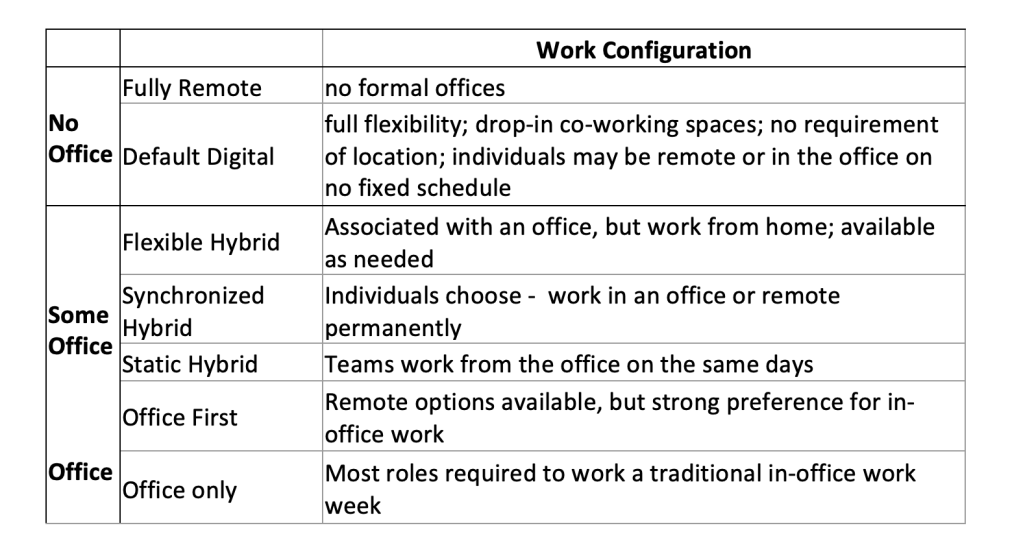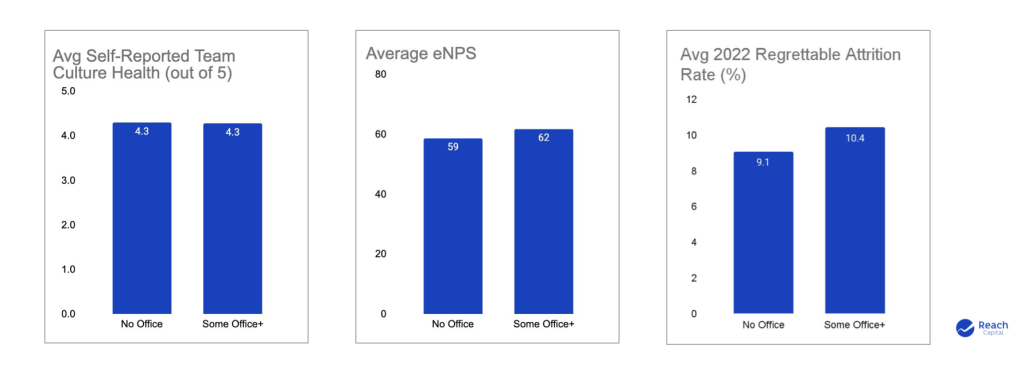Startups With Onsite Employees Grow 3 1/2 Times Faster

Data shows that pre-seed and seed startups with employees showing up in a physical office have 3 ½ times higher revenue growth than those that are solely remote.
Let the discussion begin.
During the pandemic, companies engaged in one of the largest unintended experiments in how to organize office work – remotely, in offices, or a hybrid of the two. Post-pandemic, startups are still struggling to manage the best way to manage return-to-office issues – i.e. employee’s expectations of continuing to work remotely versus the best path to build and grow a profitable company.
Before we can ask which is the best configuration, the first question is what, exactly, do we mean by “remote work” versus “office work”? Today work configurations span the spectrum from no office (fully remote, default digital) to some office (flexible hybrid, synchronized hybrid, office first,) to office only.
James Kim at Reach Capital, an early-stage tech ed investor, surveyed their portfolio of 37 companies using the following taxonomy of how virtual and physical work could be configured.

Using this model James found that pre-seed and seed-stage startups that had employees returning to some type of office had 3 ½ times the revenue growth of startups that were fully remote. Those are staggeringly large differences, and while other factors may play some role (see “What Does This Mean," below), the impact of the all-hands-on-deck approach can’t be ignored.

What might account for these differences? Not surprisingly, almost 90% of the responses from pre-seed/seed startups said team culture was influenced by work configuration. However, unexpectedly, self-reported team culture, eNPS (employee Net Promoter Score) and regrettable attrition – departures that hurt the company -- were similar across work configurations for all groups.

So while the employees in all groups said regardless of the office configuration the team culture didn’t appear to change, the performance of very early stage startups (as measured by revenue growth) told a different story. The data indicates that especially during the pre-seed/seed stages, companies with some office presence grow significantly faster than those with no office presence.
What Does This Mean?
The data is suggestive but not conclusive. See a full summary of the survey results here.
Let’s start with the data set. The survey sample size was 37 companies from the Reach Capital portfolio. That’s large enough to see patterns, but not large enough to generalize across all startups. Next, Reach Capital’s portfolio of companies are in education and the future of work. The revenue results by workplace configuration may be different in other markets. Reach Capital’s investments are made in many regions including Brazil, so the geography is not limited to Silicon Valley.
Finally office configuration is only one factor that might influence a startup's growth rate. Still the results are suggestive enough that other VC’s might want to run the same surveys across their portfolio of companies and see if the results match.
(By the way, Stanford University economist Nick Bloom and others have done extensive research with thousands of people on remote and hybrid work here, and here. Their research is mostly focused on employees working on independent day-to-day tasks, such as travel agents. However, we’re interested in the very specific subset of creative knowledge workers in the early stage of startups -- specifically at the stage when startups are searching for product/market fit and a business model, not when they are executing day-to-day tasks.)
If the results appear elsewhere, then one can speculate why. Working from home may offer more distractions by chores, family, network issues. Do those little things add up to meaningful productivity differences?
Is it that in early-stage startups the random conversations between employees at unscheduled and unplanned times lead to better insights and ideas? And if so, is the productive brainstorming occurring inside of departments --e.g. engineer to engineer -- or is it the cross-fertilization between departments – e.g. engineering to marketing?
Research since the 20th century has proven that informal face-to-face interaction is important for the coordination of group activities, maintaining company culture, and team building. This informal information gives employees access to new, non-redundant information through connections to different parts of an organization’s formal org chart and through connections to different parts of an organization’s informal communication network. In addition, research has found that creativity is greatly enhanced in a “small world network" - a network structure that is both highly locally clustered and often a hotbed of unscheduled fluid interactions that support innovation. In other words, inside an early-stage startup.
For decades Silicon Valley company founders and investors have known this small world network effect as tacit knowledge. It has been a hallmark of the physical design of Silicon Valley office space - from Xerox PARC to Pixar’s headquarters, to Google and Apple.
So perhaps the converse is true. Does remote work with ad hoc or fixed meetings via Zoom actually stunt the growth of creativity and new insights, just at the time a startup most needs them? Are there new tools such as Discord and others that can duplicate the water cooler effect of physical proximity?
Either way, it’s the beginning of an interesting discussion.
What has been your experience? Feel free to share your thoughts in the comment section below!
Lessons Learned
- Data from one VC shows pre-seed and seed-stage startups with employees that show up to the office have 3 ½ times the revenue growth of those that work remotely.
- Is the data valid? Is it the same in all markets/industries?
- If it’s valid, why?
- Is there a difference in remote vs. in-office productivity for creative tasks versus execution tasks?


